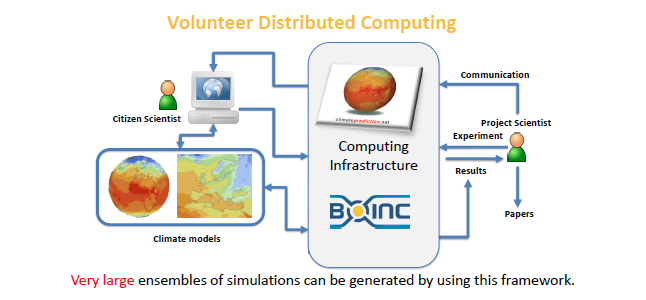OpenIFS@home: Using citizen science to improve our understanding of weather and hydrological forecasts
The history of HEPEX is deeply connected to ensemble forecasting and uncertainty analysis. Indeed, none of us could even imagine a forecast without uncertainties (apart from McFool).
One direction of research is to investigate the value in improving forecasts using a coupled system and truly understand the interactions between the atmosphere and the land surface whilst analysing the associated uncertainties. However, any analysis is limited by the resources one has available.
To run a large number of ensembles, one would need a High Performance Computing cluster which many of us do not have access to (and even if you have access, you may not have enough time/space available to realise your wildest dreams). This is not an issue which is unique to meteorological or hydrological forecasting, but arguably also exists on a much larger scale in climate modelling.
Parts of the climate community have addressed this issue by involving volunteer computing into climate model simulations through the climateprediction.net (CPDN) programme. In volunteer computing the public’s home computers are used to run climate models to help answer questions about how climate change is affecting our world, now and in the future. This methodology allows anybody to donate resources to help discover and better understand how the climate is changing by downloading the free software on their computer and connecting to the project. The results generated are sent back and aggregated for analysis as a coherent dataset available to the researcher.
These computer models simulate current and possible future climate, including temperature, rainfall and wind as well as the probability of extreme weather event occurrence. The more times the model is run, the more we are able to understand the uncertainties within the models, and hence improve our understanding of the climate system.
The volunteer computing paradigm allows the creation of massive ensembles of the order of several thousand ensemble members. The analysis of these data using standard tools allows the community to have confidence in the underlying science, just with improved statistics.
CPDN is a well proven and demonstrated system, having run previous generation UK Met Office models for over 14 years and connecting during this time with over 600,000 enthusiastic volunteers across the world. The results and analyses of these experiments contributed to multiple past IPCC reports.
What if we were able to do the same for hydro-meteorological modelling?
We could run thousands of ensembles, explore huge parameter and state spaces and indulge ourselves in an endless amount of data and results! ECMWF has contracted the University of Oxford to bring OpenIFS, which is ECMWF’s global Integrated Forecasting System, to the citizen scientists and from June onwards YOU could be using it.
OpenIFS@home is being launched this week, during the OpenIFS workshop (17th -21st June 2019) in Reading.
What could you do? Future large ensemble multi-model study possibilities are:
- Run very large ensembles of multiple different models to be run simply under a single framework.
- Multi-model large ensembles of extreme weather events occurring around the globe will be available for subsequent impact studies.
- Not only will large initial conditions ensembles be possible, but also large multi-model perturbed parameter experiments. Comparing results across multiple models could provide valuable insight into fundamental model processes and guide future model development.
- …. your imagination is the ONLY limit!
Want to get involved? Sign up today at climateprediction.net and get in contact with the openIFS@home team
OpenIFS is both an ECMWF model and a project. The OpenIFS project at ECMWF encourages research and teaching in numerical weather prediction, from medium range to seasonal timescales. An easy-to-use version of the ECMWF global Integrated Forecasting System, the OpenIFS model, is available to academic and research institutions. The OpenIFS model provides the same forecast capability as IFS but without the data assimilation system. Supporting software and documentation is also provided.
Interested? Contact us on https://www.cpdn.org/cpdnboinc/oifs_contact.php

0 comments